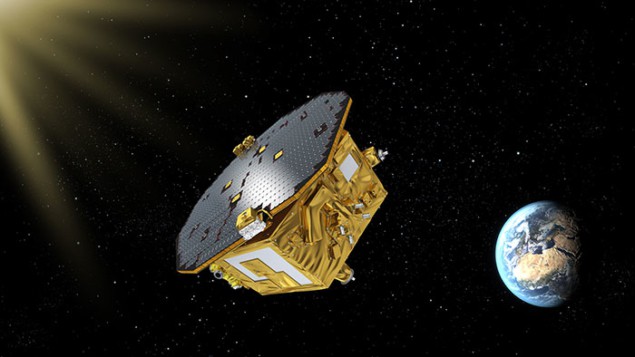
Gravitational waves hit the headlines in February last year when the LIGO collaboration announced it had detected them directly for the first time using a pair of huge laser interferometers in the US. With a further five sightings reported since then by LIGO and its European counterpart Virgo, scientists have begun to open what they call a new window on the universe. Now, keen to open that window as wide as possible, several groups have proposed sending atomic interferometers into space to observe gravitational waves that are difficult to intercept on the ground.
Gravitational waves are ripples in space–time that create tiny periodic expansions and contractions of space along orthogonal axes as they propagate forward. And, like any waves, they come in a range of frequencies. LIGO, which stands for the Laser Interferometer Gravitational-wave Observatory, detects them by monitoring a change in the relative phase of two perpendicular laser beams. However, at frequencies below about 10 Hz, this signal tends to be drowned out by terrestrial sources of noise, such as seismic waves.
Free-floating masses
To avoid such interference and detect low-frequency waves, physicists are eager to launch interferometers into the quiet of space. The €1.5bn Laser Interferometer Space Antenna (LISA) would consist of three spacecraft positioned millions of kilometres apart in a triangular formation, and would detect gravitational waves by monitoring the interference between laser beams bounced back and forth off free-floating test masses inside each spacecraft. First proposed about 25 years ago, the project has suffered a series of funding problems and was only officially inserted into the European Space Agency’s science programme in June this year, following the successful completion of its predecessor LISA Pathfinder. Its launch is planned for 2034.
“Quantum sensors might allow a reduction of costs, complexity, risks and permit an increased range of observation,”
Guglielmo Tino, University of Florence
According to Guglielmo Tino of the University of Florence in Italy, however, a mission based on the interference of matter waves could potentially be cheaper than one requiring laser interference. That is because while LISA needs at least three spacecraft to carry out multiple measurements of any passing gravitational wave – otherwise an apparent signal might simply be due to random fluctuations in laser frequency – an atomic interferometer could get away with two. “Quantum sensors might allow a reduction of costs, complexity, risks and permit an increased range of observation,” says Tino.
Earlier this month, physicists at Stanford University and the University of California Berkeley outlined plans for the Mid-band Atomic Gravitational Wave Interferometric Sensor (MAGIS). It would consist of two satellites positioned about 40,000 km apart in orbit around the Earth, each of which would contain an ensemble of ultracold strontium atoms brought into and out of superposition by a laser fired between the satellites. Any passing gravitational wave would change the laser’s flight time, resulting in different relative phase shifts between the two interferometer arms in each spacecraft.
Speculative cosmological sources
In effect, says Stanford’s Mark Kasevich, the interferometers would serve as atomic clocks while the laser beam would start and stop those clocks at intervals that depend on its passage through space–time. Kasevich and colleagues say that MAGIS could achieve “scientifically interesting” sensitivities to gravitational waves in a frequency band extending from about 30 mHz to 10 Hz, putting it between the ranges available to LISA and LIGO. At lower frequencies it could observe the merger of white dwarfs, while at the higher end of the spectrum, they say, it might see “more speculative cosmological sources” such as inflation. In addition, it could detect some sources, such as merging black holes or neutron stars, before LIGO does, and as such, allow astronomers operating conventional electromagnetic telescopes to point their devices to the relevant patch of sky ahead of time.
MAGIS is somewhat like a proposal put forward last year by a collaboration at the JILA research institute in Colorado and Harvard University, which features two satellites sharing a single laser link. However, whereas that mission would trap its atoms using lasers, in MAGIS the atom clouds would float freely. That would isolate the atomic clocks from any spacecraft vibration, Kasevich explains.
Meanwhile, a group at the Wuhan Institute of Physics and Mathematics in China has just unveiled an even more ambitious proposal. Called the Atom Interferometric Gravitational-wave Space Observatory, it would use atoms to detect gravitational waves directly rather than to measure the waves’ effect on a laser beam. This would involve three satellites splitting, deflecting and recombining a beam of atoms to create a single interferometer sensitive to a distortion of space–time known as the Sagnac effect that would be induced by gravitational waves.
Smaller size, lower cost
Group member the Dongfeng Gao explains that the observatory could be much smaller than other space-based interferometers – its envisaged length being just 10 km – since the matter waves would have a far shorter wavelength than light. Hopefully, he says, that would lead to a “cut-down in relevant technological requirements and in expense”.
Shimon Kolkowitz of the JILA/ Harvard group praises the “exciting” new proposals, but warns that they will need further R&D on the ground before they can be made “space-ready”. Indeed, Kasevich has not even costed his group’s mission, although he reckons that the price tag would “probably be greater than $1bn”. He says that it is “hard to know how far the technology can be pushed until you start to build the apparatus”.



